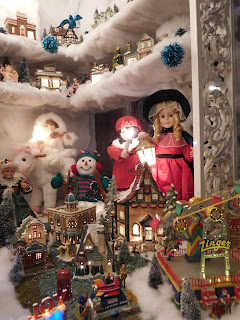I know that for many people, 2015 has been a terrible, tragic year. I feel their pain, not in the least because at least one devastating event touched my life, if only tangentially.
Still, this year has been a very good year for me---the best since my surgery, and possibly before that--in many ways. Cycling has had much to do with that.
Of course, riding to and from museums and cafes, along rivers, canals and boulevards, and through new experiences as well as memories, in Montreal and Paris can make just about anybody's year. What really made those events, and much else in my life, special this year is an observation my friend Jay made while we had lunch in the City of Light: "You seem very settled as a woman now."
The last time we'd met before then, I was in the early stages of my gender transition. I was still acting and dressing in ways I was "supposed" to. To be more precise, I was trying to show that I wasn't a man. (That, after I'd spent so much of my life trying to prove the exact opposite!) At that point in my life, I really wondered whether I could or wanted to continue cycling. For one thing, I knew that I couldn't continue to ride in the way in which I'd been accustomed. More important, though, I still believed that my transition meant "killing", if you will, the man named Nick I had lived as. For that reason, I also wondered whether I would continue teaching although most people don't think of it as a particularly "masculine" occupation.
Since then, I have come to realized that cycling and teaching, as well as writing and even my taste in foods, are not part of one gender or another; they are part of my identity. In other words, they intertwine with other things to make me who I am. When anything is so integral to your life, you don't dispose or efface it; it changes with you or you change it as you are changing yourself. So, perhaps, the way you execute or express them changes.
In my case, pedaling up a hill or writing an essay or poem is no longer a conquest or even a goal met; it is an accomplishment, on whatever scale. Sometimes I still think about how Nick would have seen all of this--he wouldn't have approved, I'm sure--but I feel compassion for him. After all, he couldn't have understood that he was, even then, becoming me. Yes, she was becoming her mother!
It's fun, really. And the cycling has gotten better. That's what 2015 means to me right now.
Still, this year has been a very good year for me---the best since my surgery, and possibly before that--in many ways. Cycling has had much to do with that.
Of course, riding to and from museums and cafes, along rivers, canals and boulevards, and through new experiences as well as memories, in Montreal and Paris can make just about anybody's year. What really made those events, and much else in my life, special this year is an observation my friend Jay made while we had lunch in the City of Light: "You seem very settled as a woman now."
The last time we'd met before then, I was in the early stages of my gender transition. I was still acting and dressing in ways I was "supposed" to. To be more precise, I was trying to show that I wasn't a man. (That, after I'd spent so much of my life trying to prove the exact opposite!) At that point in my life, I really wondered whether I could or wanted to continue cycling. For one thing, I knew that I couldn't continue to ride in the way in which I'd been accustomed. More important, though, I still believed that my transition meant "killing", if you will, the man named Nick I had lived as. For that reason, I also wondered whether I would continue teaching although most people don't think of it as a particularly "masculine" occupation.
Since then, I have come to realized that cycling and teaching, as well as writing and even my taste in foods, are not part of one gender or another; they are part of my identity. In other words, they intertwine with other things to make me who I am. When anything is so integral to your life, you don't dispose or efface it; it changes with you or you change it as you are changing yourself. So, perhaps, the way you execute or express them changes.
In my case, pedaling up a hill or writing an essay or poem is no longer a conquest or even a goal met; it is an accomplishment, on whatever scale. Sometimes I still think about how Nick would have seen all of this--he wouldn't have approved, I'm sure--but I feel compassion for him. After all, he couldn't have understood that he was, even then, becoming me. Yes, she was becoming her mother!
It's fun, really. And the cycling has gotten better. That's what 2015 means to me right now.




































